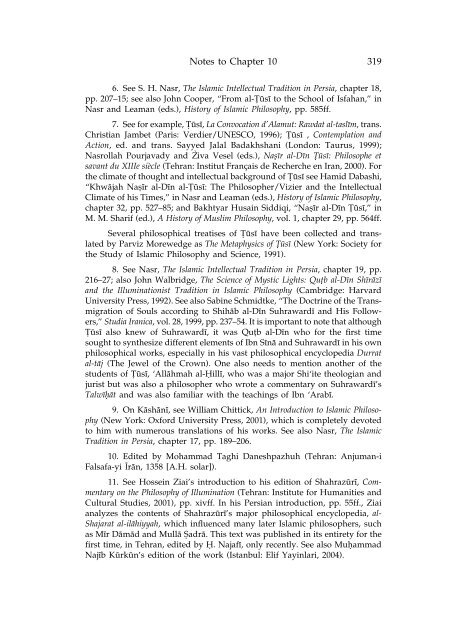Islamic Philosophy from Its Origin to the Present: Philosophy in the ...
Islamic Philosophy from Its Origin to the Present: Philosophy in the ...
Islamic Philosophy from Its Origin to the Present: Philosophy in the ...
You also want an ePaper? Increase the reach of your titles
YUMPU automatically turns print PDFs into web optimized ePapers that Google loves.
Notes <strong>to</strong> Chapter 10 319<br />
6. See S. H. Nasr, The <strong>Islamic</strong> Intellectual Tradition <strong>in</strong> Persia, chapter 18,<br />
pp. 207–15; see also John Cooper, “From al-apple¨s¥ <strong>to</strong> <strong>the</strong> School of Isfahan,” <strong>in</strong><br />
Nasr and Leaman (eds.), His<strong>to</strong>ry of <strong>Islamic</strong> <strong>Philosophy</strong>, pp. 585ff.<br />
7. See for example, apple¨s¥, La Convocation d’Alamut: Rawdat al-tasl¥m, trans.<br />
Christian Jambet (Paris: Verdier/UNESCO, 1996); apple¨s¥ , Contemplation and<br />
Action, ed. and trans. Sayyed Jalal Badakhshani (London: Taurus, 1999);<br />
Nasrollah Pourjavady and Z v<br />
iva Vesel (eds.), Na„¥r al-D¥n T¶s¥: Philosophe et<br />
•<br />
savant du XIIIe siècle (Tehran: Institut Français de Recherche en Iran, 2000). For<br />
<strong>the</strong> climate of thought and <strong>in</strong>tellectual background of apple¨s¥ see Hamid Dabashi,<br />
“Khwåjah Na∑¥r al-D¥n al-apple¨s¥: The Philosopher/Vizier and <strong>the</strong> Intellectual<br />
Climate of his Times,” <strong>in</strong> Nasr and Leaman (eds.), His<strong>to</strong>ry of <strong>Islamic</strong> <strong>Philosophy</strong>,<br />
chapter 32, pp. 527–85; and Bakhtyar Husa<strong>in</strong> Siddiqi, “Na∑¥r al-D¥n apple¨s¥,” <strong>in</strong><br />
M. M. Sharif (ed.), A His<strong>to</strong>ry of Muslim <strong>Philosophy</strong>, vol. 1, chapter 29, pp. 564ff.<br />
Several philosophical treatises of apple¨s¥ have been collected and translated<br />
by Parviz Morewedge as The Metaphysics of T • ¶s¥ (New York: Society for<br />
<strong>the</strong> Study of <strong>Islamic</strong> <strong>Philosophy</strong> and Science, 1991).<br />
8. See Nasr, The <strong>Islamic</strong> Intellectual Tradition <strong>in</strong> Persia, chapter 19, pp.<br />
216–27; also John Walbridge, The Science of Mystic Lights: Qu†b al-D¥n Sh¥råz¥<br />
and <strong>the</strong> Illum<strong>in</strong>ationist Tradition <strong>in</strong> <strong>Islamic</strong> <strong>Philosophy</strong> (Cambridge: Harvard<br />
University Press, 1992). See also Sab<strong>in</strong>e Schmidtke, “The Doctr<strong>in</strong>e of <strong>the</strong> Transmigration<br />
of Souls accord<strong>in</strong>g <strong>to</strong> Shihåb al-D¥n Suhraward¥ and His Followers,”<br />
Studia Iranica, vol. 28, 1999, pp. 237–54. It is important <strong>to</strong> note that although<br />
apple¨s¥ also knew of Suhraward¥, it was Qu†b al-D¥n who for <strong>the</strong> first time<br />
sought <strong>to</strong> syn<strong>the</strong>size different elements of Ibn S¥nå and Suhraward¥ <strong>in</strong> his own<br />
philosophical works, especially <strong>in</strong> his vast philosophical encyclopedia Durrat<br />
al-tåj (The Jewel of <strong>the</strong> Crown). One also needs <strong>to</strong> mention ano<strong>the</strong>r of <strong>the</strong><br />
students of apple¨s¥, ‘Allåhmah al-¡ill¥, who was a major Shi‘ite <strong>the</strong>ologian and<br />
jurist but was also a philosopher who wrote a commentary on Suhraward¥’s<br />
Talw¥÷åt and was also familiar with <strong>the</strong> teach<strong>in</strong>gs of Ibn ‘Arab¥.<br />
9. On Kåshån¥, see William Chittick, An Introduction <strong>to</strong> <strong>Islamic</strong> <strong>Philosophy</strong><br />
(New York: Oxford University Press, 2001), which is completely devoted<br />
<strong>to</strong> him with numerous translations of his works. See also Nasr, The <strong>Islamic</strong><br />
Tradition <strong>in</strong> Persia, chapter 17, pp. 189–206.<br />
10. Edited by Mohammad Taghi Daneshpazhuh (Tehran: Anjuman-i<br />
Falsafa-yi Árån, 1358 [A.H. solar]).<br />
11. See Hosse<strong>in</strong> Ziai’s <strong>in</strong>troduction <strong>to</strong> his edition of Shahraz¨r¥, Commentary<br />
on <strong>the</strong> <strong>Philosophy</strong> of Illum<strong>in</strong>ation (Tehran: Institute for Humanities and<br />
Cultural Studies, 2001), pp. xivff. In his Persian <strong>in</strong>troduction, pp. 55ff., Ziai<br />
analyzes <strong>the</strong> contents of Shahraz¨r¥’s major philosophical encyclopedia, al-<br />
Shajarat al-ilåhiyyah, which <strong>in</strong>fluenced many later <strong>Islamic</strong> philosophers, such<br />
as M¥r Dåmåd and Mullå |adrå. This text was published <strong>in</strong> its entirety for <strong>the</strong><br />
first time, <strong>in</strong> Tehran, edited by ¡. Najaf¥, only recently. See also Mu±ammad<br />
Naj¥b K¨rk¨n’s edition of <strong>the</strong> work (Istanbul: Elif Yay<strong>in</strong>lari, 2004).

















